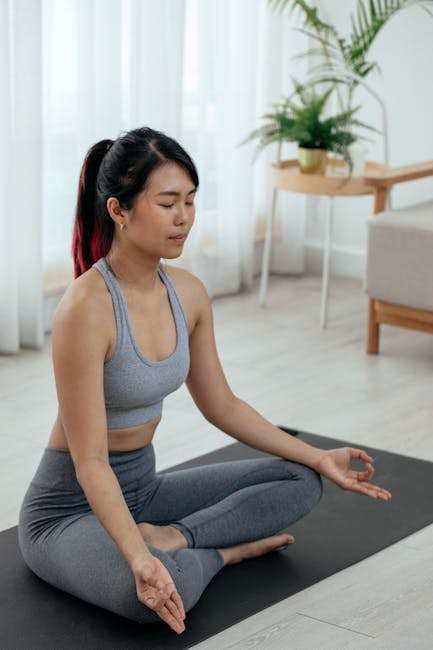Introduction
Our breath is a powerful tool that we carry with us at all times, yet many of us overlook its potential for promoting relaxation, focus, and overall well-being. Breathing exercises are simple yet effective techniques that can help us tap into this potential. They involve consciously controlling the rate, depth, and pattern of our breaths to influence our mental, emotional, and physical states.
These exercises are not just for yogis or meditation practitioners; anyone can benefit from learning and practicing them. Whether you’re feeling stressed, anxious, fatigued, or simply want to boost your focus and energy levels, there’s a breathing exercise that can help. So, let’s dive into the world of conscious breathing and explore how it can enhance your life.
Before we delve into specific techniques, it’s important to understand why breathing exercises are so beneficial. The act of breathing is not just a physical process; it’s closely linked to our mental and emotional states. When we’re stressed or anxious, our breathing tends to become shallow and rapid. On the other hand, when we’re relaxed and calm, our breathing is slow and deep. By consciously controlling our breath, we can influence our mental and emotional states, promoting relaxation, reducing stress, and enhancing focus and energy levels.
Understanding the Basics of Breathing
At the core of effective breathing exercises is a deep understanding of how breathing works. The diaphragm, a large muscle located below the lungs, plays a crucial role in breathing. When we inhale, the diaphragm contracts and moves downward, creating space for the lungs to expand and fill with air. When we exhale, the diaphragm relaxes and moves upward, pushing air out of the lungs.
There are different types of breathing patterns that we can adopt. Shallow breathing involves short, quick breaths that only fill the upper part of the lungs. Deep breathing, also known as diaphragmatic breathing, involves longer, slower breaths that fill the entire lungs, including the lower parts. Rapid breathing involves quick, short breaths, while slow breathing involves longer, slower breaths.
The way we breathe can also affect our nervous system. Rapid, shallow breathing can stimulate the sympathetic nervous system, which is responsible for the “fight or flight” response. This can lead to feelings of anxiety and stress. On the other hand, slow, deep breathing can stimulate the parasympathetic nervous system, which is responsible for the “rest and digest” response. This can promote relaxation and calmness.

Simple Breathing Techniques for Relaxation
One of the most popular breathing exercises for relaxation is deep belly breathing. This involves taking slow, deep breaths that fill the entire lungs, including the lower parts. This can help to stimulate the parasympathetic nervous system, promoting relaxation and calmness. To practice deep belly breathing, sit or lie down in a comfortable position, place one hand on your belly, and take slow, deep breaths, focusing on the rise and fall of your belly as you breathe.
The 4-7-8 breathing technique is another effective exercise for relaxation. This involves inhaling for a count of 4, holding the breath for a count of 7, and exhaling for a count of 8. This pattern helps to slow down the breath and promote a sense of calm and relaxation.
Alternate nostril breathing, a traditional yoga breathing practice, is also a great technique for relaxation. This involves inhaling through one nostril, holding the breath, and then exhaling through the other nostril. This pattern is repeated for several rounds, alternating the nostril through which you inhale and exhale.
Breathing Exercises for Stress Relief
Box breathing is a powerful technique for stress relief. This involves inhaling, holding the breath, exhaling, and holding the breath again, each for a count of 4. This creates a “box” pattern, hence the name. Box breathing can help to slow down the breath, calm the mind, and reduce stress.
Progressive muscle relaxation combined with deep breathing is another effective exercise for stress relief. This involves tensing and then relaxing different muscle groups in the body, combined with deep, slow breaths. This can help to release physical tension and promote a sense of calm and relaxation.
Breath counting meditation is a simple yet powerful technique for stress relief. This involves counting your breaths from 1 to 10, and then starting over again. This can help to focus the mind, reduce mental chatter, and promote a sense of peace and calm.

Breathing Techniques for Energy and Focus
Kapalabhati, also known as skull-shining breath, is a traditional yoga breathing practice that can help to boost energy and focus. This involves taking quick, forceful exhales and passive inhales. This can help to energize the body, clear the mind, and improve focus.
Breath of Fire is another powerful technique for energy and focus. This involves taking quick, equal inhales and exhales through the nose. This can help to energize the body, clear the mind, and improve focus.
Bellows breath, also known as Bhastrika Pranayama in yoga, is a powerful technique for energy and focus. This involves taking quick, forceful inhales and exhales through the nose, like a bellows. This can help to energize the body, clear the mind, and improve focus.
Incorporating Breathing Exercises into Daily Life
Finding the right time and place for breathing exercises can make a big difference in their effectiveness. Some people find it helpful to practice breathing exercises first thing in the morning to start their day on a positive note. Others prefer to practice them during the day to manage stress, or in the evening to wind down before bed. It’s important to find a quiet, comfortable place where you won’t be disturbed.
Combining breathing exercises with other activities can also enhance their benefits. For example, you can combine breathing exercises with yoga poses, mindfulness practice, or visualization meditation to create a comprehensive mind-body practice.
Creating a consistent breathing practice is key to reaping the benefits of breathing exercises. This involves setting aside a specific time each day for breathing exercises, and sticking to it. Over time, this can help to create a habit that can enhance your well-being in many ways.

Photo by Miriam Alonso on Pexels
Conclusion
In conclusion, breathing exercises are a simple yet powerful tool for promoting relaxation, reducing stress, and enhancing focus and energy levels. By understanding the basics of breathing and practicing different breathing techniques, we can tap into the power of our breath and enhance our well-being in many ways.
We encourage you to start incorporating breathing exercises into your daily routine. Whether you’re feeling stressed, anxious, fatigued, or simply want to boost your focus and energy levels, there’s a breathing exercise that can help. Remember, the key to reaping the benefits of breathing exercises is consistency, so make sure to set aside a specific time each day for your breathing practice.
Finally, we invite you to explore the transformative power of conscious breathing. As you delve deeper into the world of breathing exercises, you’ll discover that your breath is not just a physical process, but a powerful tool for enhancing your mental, emotional, and physical well-being. So, take a deep breath, and embark on your journey to better health and well-being with breathing exercises.
#BreatheEasy #MindfulBreathing #DeepBreaths #BreathWork #StressRelief




Pingback: Relaxing Fireplace Ambience: 4 Captivating Videos To Elevate Your Serenity